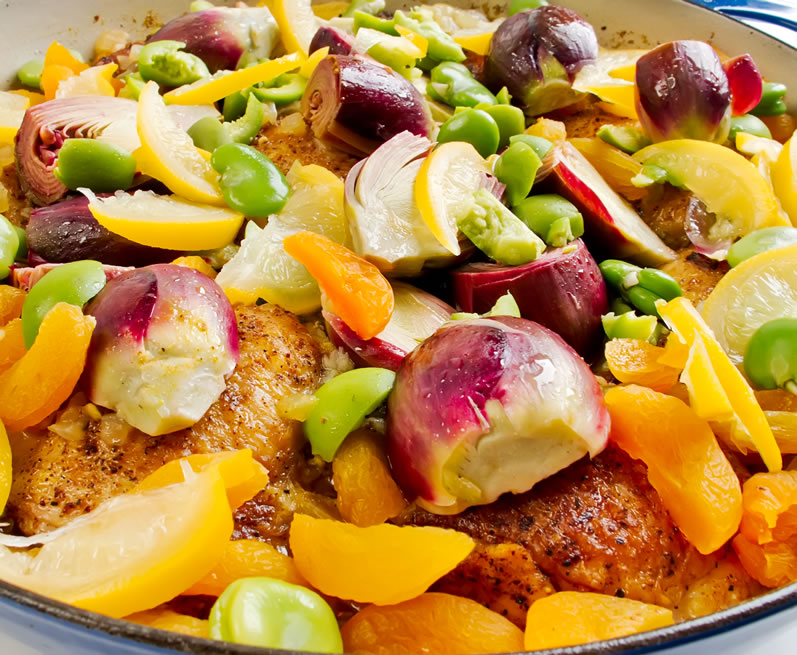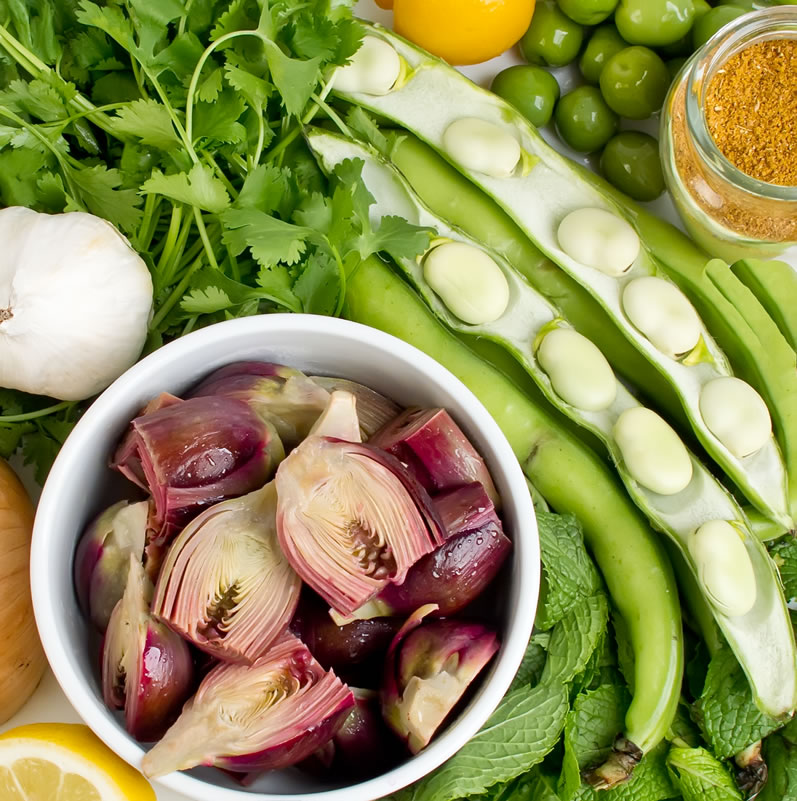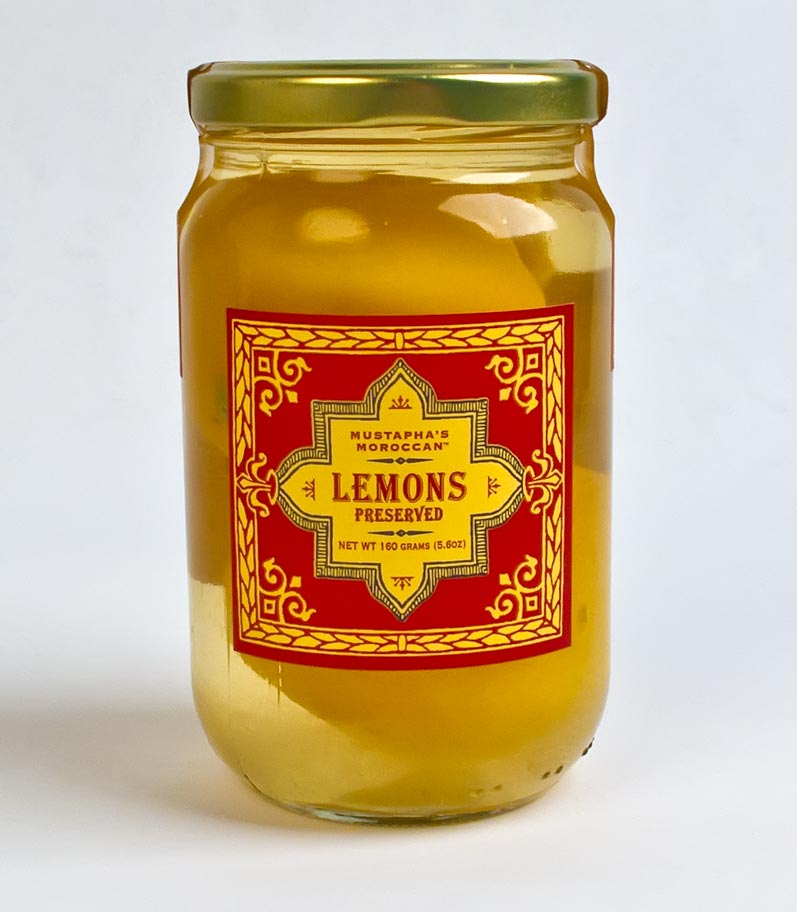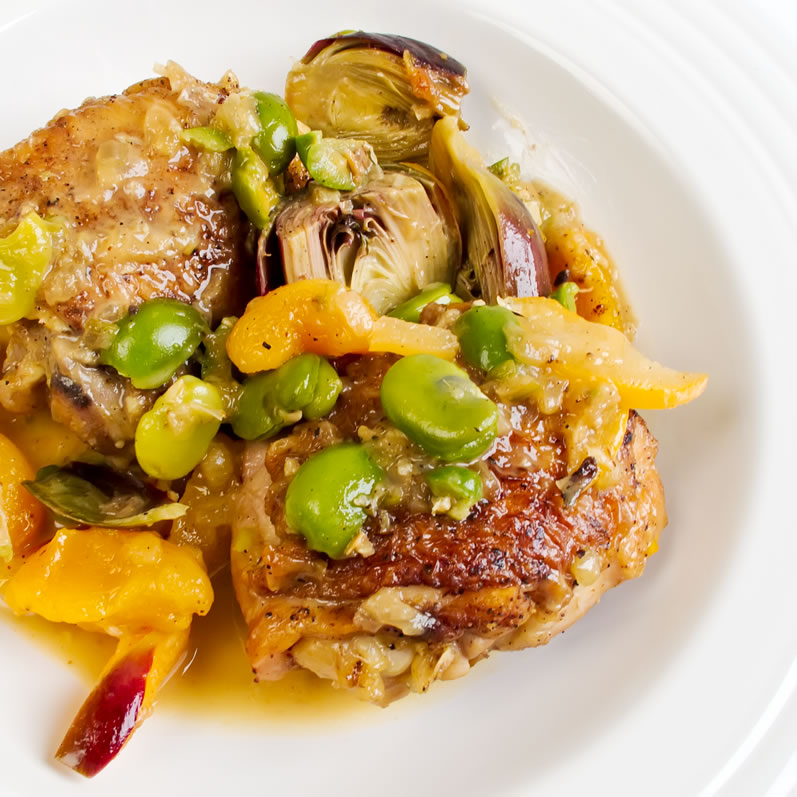On the LunaCafe Facebook page recently, I bemoaned the fact that this is an atypically chilly and dreadfully dreary May in the Northwest. By chilly, I mean most days are in the 50’s, which forces me to put on three layers of everything just to step out the door. This is not the kind of weather that makes me all dreamy-eyed about eating cold, composed salads, no matter how much I will crave them once summer finally kicks in.
Instead, I find myself jotting down ideas for Moroccan tagines. Why? Because they are hot, spicy, succulent, and so damn delicious that not even the weather can bring me down when I’m eating one. In case you aren’t familiar with the world of tagines, they are basically fragrant, tender, silky braises of meat, seafood, and/or vegetables that contain the following elements:
Foundation Ingredients (the first two are essential; then one or more of the others)
- fat (olive oil, clarified butter)
- aromatics (onions or shallots, garlic, and possibly fresh ginger)
- seafood (prawns, crab, lobster, or almost any variety of fish)
- meat (chicken, duck, squab, beef, lamb, goat, or chorizo sausage)
- veggies (artichokes, fava beans, tomatoes, chick peas, turnips, carrots, pumpkin, winter squash, potatoes, bell peppers, fennel, peas, yams, sweet potatoes, eggplant, beets, okra, zucchini, cauliflower, and/or string beans)
- dried beans (chick peas, butter beans, or lima beans)
Auxiliary Ingredients (the first two are de rigueur; the rest are optional)
- a warm blend of spices (cinnamon, nutmeg, allspice, ginger, turmeric, coriander, cumin, paprika, mace, galangal, orris root, anise seeds, cardamom, cloves, white or black peppercorn, and/or saffron, or ras el hanout, or baharat)
- a silky reduction sauce
- fresh or dried herbs (thyme, oregano, rosemary, cilantro, basil, and/or bay leaf)
- something sour (preserved lemon, fresh lemon, and/or fresh lime)
- something sweet (apricots, pears oranges, grapes, quince, pomegranate, raisins, prunes, dates, figs, and/or honey)
- something floral (rose petals, lavender, orris root, and/or rose water or orange blossom water)
- something sharp (green or black olives)
- something hot (Harissa, fresh chiles, and/or dried chiles)
- something nutty (almonds, pistachios, or sesame seeds)
- a finish of chopped fresh herbs (parsley, mint, and/or cilantro)
How can this combination of elements be anything but uplifting? And if you follow these basic guidelines, using the recipe below as a template, you can make countless wonderful tagines without even opening a cookbook.
EQUIPMENT NOTE You do not need a traditional Moroccan tagine to make a tagine. (Yes, the same word describes the cooking vessel and the dish cooked in the vessel.) These are uncoated earthenware bases, fitted with cone-shaped lids. You must soak the porous clay in water for two hours prior to cooking over a Moroccan brassier, or the pottery will crack. In any case, these low-fired vessels cannot withstand the direct heat of a gas or electric stove. Emile Henry, Le Creuset, and Staub all make tagines that can withstand the heat of an American stovetop. But the last thing my overstuffed kitchen cupboards need is another large piece of specialized equipment, so I prefer to use this Le Creuset, 3½ quart, enameled cast iron casserole, which is perfect for a wide range of sautés, braises, and stews. Any 3½ quart, heavy weight, stovetop casserole with a tight-fitting lid will work.
TECHNIQUE NOTE There are three classic methods for preparing chicken: sautéing, braising, and stewing. In essence, each is distinguished from the others by the amount of liquid used to complete the cooking. Typically, a saute contains up to ½ cup of liquid, a braise contains ½ to 2 cups liquid, and a stew contains over 2 cups liquid.
Tagines are usually braises, as you want enough sauce to coat the ingredients and to moisten the couscous that is traditionally served with the tagine, but not so much that the main ingredients are floating in liquid. In order for the sauce to achieve a texture that will lightly coat a spoon, there must be sufficient body-giving aromatics and fat in the recipe. Onions melt down to a silky texture when cooked very slowly over time, so they make a perfect base for most tagines. If you look at cookbooks on Moroccan cuisine, you will also notice that most tagines contain anywhere from 4 to 16 tablespoons of fat. That may seem like a lot, but if you cut back too far on the fat, you won’t have a sauce that will lightly coat a spoon. Just a heads up on that.
Chicken Tagine with Baby Artichokes, Green Olives, Apricots & Preserved Lemon
This tagine borrows a technique I use for almost all chicken dishes these days; namely a 24-hour dry-cure with coarsely ground sea salt. You won’t believe the difference it makes to salt chicken for at least 12 hours before you cook it. The meat becomes incredibly tender and moist, and the seasoning works its way into the interior flesh in the most magical way.
ADVANCE PREP For best results, begin this dish a day in advance. Prepare the ras el hanout, dry cure the chicken, and marinate the artichokes. With these steps completed, this dish is a cinch to prepare.
4 teaspoons ras el hanout, approximately
8 fresh, plump chicken thighs
sea salt in a grinder
1 pound baby artichokes (any color), outer leaves removed, tops trimmed by 1 inch, stems trimmed and peeled, cut in half lengthwise, and put into acidulated water
2 tablespoons fresh lemon juice
2 tablespoons cold-pressed, extra virgin olive oil
2 cloves garlic, peeled and minced or pressed
½ teaspoon fine sea salt
¼ cup light olive oil
1 large yellow onion, chopped
4 cloves garlic, peeled, and minced or pressed
1 cup chicken stock
1 preserved lemon, rinsed, and cut lengthwise into thin slivers, optional if you can’t locate
20 large cracked green olives, pitted, and quartered lengthwise
20 dried apricot halves
Garnish
2 tablespoons fresh cilantro, chopped
2 tablespoons fresh mint, chopped
- Prepare ras el hanout (or purchase a blend from an upscale market). Store airtight in a cool, dark location.
- The day prior to serving, dry-cure the chicken thighs. Rinse the thighs under cold running water and pat thoroughly dry with paper towels. Grind sea salt generously over the entire thigh and sprinkle rather liberally with ras el hanout. Arrange thighs in a glass baking dish. Cover tightly with a couple layers of plastic wrap and frig for at least 12 hours (24 hours is even better).
- Prepare artichokes as described in the Artichoke Primer. Bring water to boil in the bottom of a steamer and ad the artichokes. Steam for 5 minutes.
- In the meanwhile, in a mixing bowl, combine the lemon juice, olive oil, garlic, and salt. Remove the artichokes from the steamer and toss while still hot with the vinaigrette. Cool to room temperature, cover, and frig for at least 4 hours, or up to 2 days.
- In a large skillet (with a lid for later), heat the oil and add the chicken pieces, skin-side down. Continue cooking until well browned on the first side, about 5-6 minutes. Turn the pieces over with tongs, and brown the other side, about 5-6 minutes. Remove chicken from the skillet to a large plate, and reserve.
- Pour the oil from the skillet into a glass measuring cup.
- Add ¼ cup of the oil back to the skillet. Add the onion and garlic and saute until softened but not browned, about 5 minutes. Stir in 2 teaspoons ras el hanout and continue cooking for 2 minutes. Taste the onions and add additional ras el hanout if you want a bolder flavor.
- Add the chicken back to the skillet, add the chicken stock, and cover the pan. Simmer very gently for about 20 minutes. Add the artichokes and their marinade, preserved lemons, olives, and apricots. Cover, and simmer slowly for 5-10 minutes, until the juices of the thigh run yellow rather than pink when pricked with a knife.
- Remove cover and increase heat to reduce and thicken the sauce to the point that it lightly coats a spoon. Season the sauce with salt, pepper, and additional drops of lemon juice if necessary. Spoon the sauce over the chicken and veggies.
- Serve from the skillet or arrange everything on a heated serving platter. Sprinkle with chopped cilantro and mint.
Serves 4.
Resources
- About,com: The Moroccan Tagine
- Almost Bourdain: Chicken, Almond and Olive Tagine
- Closet Cooking: Ossobuco Tagine (Moroccan Style Ossobuco)
- Foodgawker: Tagine
- Globetrotter Diaries: Moroccan Chicken Tagine with Preserved Lemons
- TasteSpotting: Tagine
- The Taste Space: Moroccan Tagine of Lima Beans, Cherry Tomatoes and Black Olives
Copyright 2011-2019 Susan S. Bradley. All rights reserved.






3 layers for 50 F weather BWHAHAHAHAHAHA!
Sorry I couldn’t help it. Now that that is out of the way lol, I love your tagine blueprint. So many people get bogged down by the same preserved lemon and olives tagine (without apricots, etc) and it even got old in Morocco! I love tagine, but I especially love creative and interesting tagine. And now I want to try this 24 hour dry salt method with chicken–I can definitely see how that would be amazing.
Laura, thank you. For me, it’s always about understanding the underlying concept and technique. That’s how I approached learning to cook (thank you Julia Child!), and that’s how I taught thousands of fledgling cooks over two decades as a cooking teacher. Recipes are blueprints only. A “real” cook understands the whys and hows. I think that’s what makes cooking so rewarding. There’s no end to the exploring and learning. It’s a marvelous adventure.
I have a beautiful Emilie tagine tucked away in the closet and preserved lemons in the fridge. What am I waiting for? This recipe looks like it would reward the effort of cutting and braising with a magnificent meal. I even read the artichoke primer, so I have no excuse, except that there is a foot of snow on the ground and my car isn’t moving for a couple of days. Ugh – just when I found the perfect recipe for the weekend. Maybe I can get a ride to the grocery store for the artichokes and the chicken? Hope so.
Laura, I feel your pain on the snow front. We lived on 5 wooded acres in the Cascade foothills for a couple of decades, and winter could be a bearcat. For one thing, the well required electricity, so when that went out (frequently and for days at a time), it was not only freezing but there was no water. Argh!!! But now we live in milder Portland, Oregon and rarely have more than a few days of snow each winter. This year, no snow at all and sunny almost every day. Do hope the snow is gone by the time you read this. You’re going to love this dish.
I want to eat at your house. Seriously the colors and flavor of that dish just speak to me.
I love the colors and flavors in your tagine! esp the purple color of the baby artichokes!! brilliant!
Alice, thanks! It was those baby purple artichokes that inspired this dish. There were huge piles of them at Portland Farmers Market, and I eventually succumbed.
This looks so amazing, I love tagines! Plus that purple hue on the baby artichokes? Just makes your photos come to life in a delectable way!
How hearty and comforting this dish looks and with a tutorial like this, how can anyone go wrong.
Joanie, very kind, thank you!
Did you use a Tagine Pot? I’ve always wanted one of those. I want to try this recipe, looks very good!
Linda, I used my much loved Le Creuset, 3½ quart, enameled cast iron casserole. It works perfectly for this and many other dishes that require stovetop-to-oven cooking. Plus, it’s pretty, and you can serve from it.